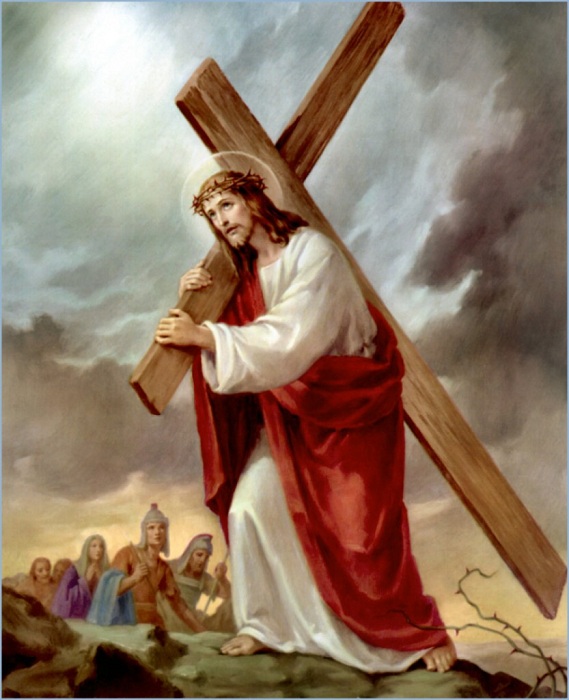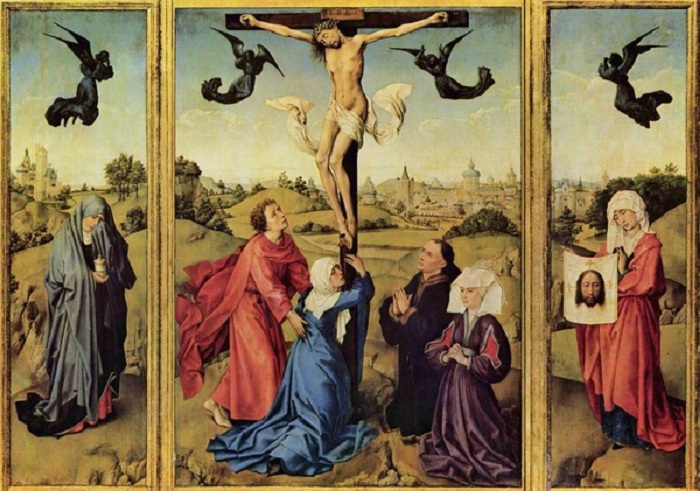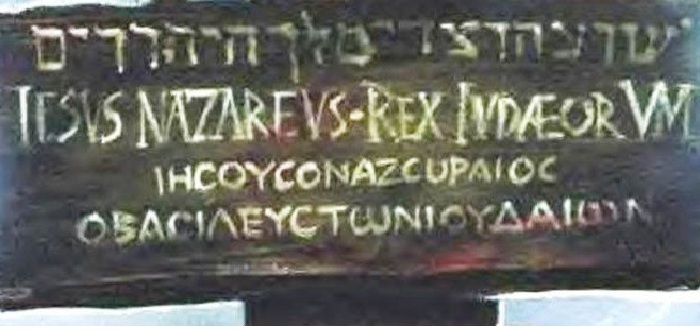Нам нередко приходилось созерцать репродукции картин мировой живописи с изображением распятия Иисуса Христа. А таких полотен, написанных старыми мастерами разных стран и художественных направлений, большое множество. Однако мало кто из нас задумывался о значении аббревиатуры на табличке над головой Спасителя и о том, почему одни художники изображали на распятии его живым и торжествующим, а иные — мертвым и застывшем в позе мученика.
Распятие на кресте — древний вид казни
Распятие на кресте — вид казни, который был весьма распространен во многих странах мира. Так казнили в Японии, Китае, Вавилонии, Греции, Палестине, Карфагене. Однако особо часто к ней прибегали в Древнем Риме. И что интересно, она была довольно распространенным наказанием в Римской империи задолго до рождества Христова.
«Причина, по которой людей распинали, часто состояла в том, что, кроме умерщвления, хотелось еще и публично унизить врага на устрашение другим. Сохранились описания того, как палач оставлял распятых в таком положении на пару часов или до заката солнца, а затем убивал их мечом» ,- писал в своих трудах профессор истории Таймон Скрич.
What Does INRI Stand For?
Иисус — вселенская любовь
Однако для многих из нас распятие ассоциируется лишь с одним историческим событием – казнью Иисуса Христа, который по доброй воле взял на себя вину всех людей и пострадал за нее позорной и мученической смертью.

Иконография. Ведение ко Кресту.
В те далекие времена всех инакомыслящих преследовали и карали беспощадно. Но Иисус и его ученики, невзирая на смертельную опасность, несли веру в народ, завоевывали сердце за сердцем, страну за страной и вовсе не оружием — а любовью. Это спустя столетия, когда христианская религия станет иметь под собой государственную основу, начнется насильственное крещение, наступят страшные времена крестоносцев и инквизиции.
А до того Сын Божий, любящий всех людей, весь род человеческий, взойдет на Голгофу и будет распят, во имя спасения наших душ. Поэтому в каждом из нас есть искра Божия и все мы ходим с нею в сердце, и верующие, и неверующие. И все жаждем любви и добра.
Да, мы знаем, «что Христос умер на кресте, но мы знаем и то, что потом он воскрес, и то, что страдал он добровольно, чтобы научить нас беречь бессмертную душу; чтобы мы тоже могли воскреснуть и жить вечно».
Образ Спасителя в православии и католицизме
В католицизме и православии существуют не только различия в форме креста (первый — четырехконечный, второй — восьмиконечный), но и в самом образе Иисуса Христа на нем. Так, до 9 столетия в иконографии Спаситель изображался на распятии не только живым, но и торжествующим. А начиная с 10 века, в Западной Европе начали появляться изображения мертвого Иисуса.
На православной интерпретации распятия облик Христа так и остался торжествующим. На кресте он «не умирает, а свободно простирает руки, ладони его открыты, будто хочет обнять все человечество, даря ему свою любовь и открывая путь к вечной жизни.»
INRI Meaning on the Cross and in the Bible
В католическом же распятии изображение Христа намного реалистичней. На нем изображают Иисуса мертвым, а иногда и с потоками крови на лице, из ран на руках, ногах и ребрах. В иконографии проявляются все страдания истязаемого человека и муки, которые пришлось испытать Сыну Божьему. На его лице следы невыносимой боли, руки провисли под тяжестью тела, которое очень правдоподобно изогнуто.

Рогир ван дер Вейден.
На католическом кресте Христос мертв, в нем нет торжества победы над смертью, того торжества, что видим в православной иконографии.
Крест Спасителя — что означает надпись на нем
Крест сопровождает христианина всю его жизнь, он его видит и в храмах и носит на груди как защиту. Поэтому каждому интересно будет узнать о значении аббревиатуры на титле распятия.
Надпись на орудии казни Спасителя — «I.Н.Ц.I.», она же — «I.N.R.I», а в некоторых восточных церквях -«I.N.B.I.» расшифровывается как «Иисус Назорянин Царь Иудейский». Первоначально эта фраза была написана на табличке на еврейском, греческом, римском языках и прикреплена к кресту, на котором принял мученическую смерть Христос. Согласно закону того времени такие надписи полагались каждому осужденному на смерть, чтобы все могли узнать о вине которую ему инкриминировали.

Титло INRI (лат. titulus) — христианская реликвия, найденная в 326 году императрицей Еленой.
Как известно со Священного писания, Понтий Пилат не нашелся, как по другому описать вину Христа, поэтому на табличке появились слова «Иисус Назорянин Царь Иудейский»
Со временем эту надпись в иконографии заменили аббревиатурой. На латыни в католицизме эта надпись имеет вид INRI, а в православии – IHЦI (либо ІНВІ, «Іисусъ Назарянинъ, Царь Іудейский»).
Существует также иная православная надпись — «Царь мира», в славянских странах — «Царь славы». Кроме того, в православной Византии сохранились гвозди, которыми Сын Божий был прибит к кресту. Согласно жизнеописанию Иисуса точно известно, что их четыре, а не три как принято изображать на католическом распятии. Поэтому на православных крестах ноги Христа прибиты двумя гвоздями — каждая по отдельности. А изображение Христа со скрещенными ступнями, пригвожденными одним гвоздем, впервые появилось на Западе во второй половине 13 столетия.
Распятие имеет еще несколько аббревиатур: над средней перекладиной помещаются надписи: «IС» «ХС» — имя Иисуса Христа; а под ней: «НИКА» — Победитель.
Распятие в немецкой живописи
Многие живописцы, обращаясь к этой теме, привнесли в историю искусства множество различных интерпретаций этой казни. Слово «crux» в переводе с латинского «крест» изначально имело более широкий смысл, и могло обозначать любой столб, на котором вешали приговоренных к смерти. К примеру, на многих полотнах видим распятие Спасителя на Т-образном кресте.
Источник: kulturologia.ru
INRI

INRI is an acronym of the Latin phrase IESVS·NAZARENVS·REX·IVDÆORVM (Jesus Nazarenus, rex Judæorum), which translates into English as «Jesus Nazarene, King of the Jews.» This title appears in the New Testament in the Passion narrative of the Gospel of John ( 19:19 ). During Jesus’ crucifixion, a Titulus Crucis (Latin for «Title of the Cross») was inscribed in wood and placed above Jesus head. In the context of the Crucifixion, the titulus IESVS NAZARENVS REX IVDAEORVM (and its translation), written in three languages (Hebrew, Latin, and Greek), was affixed to the cross. Within Western Christianity, many crucifixes and other depictions of the crucifixion include a stylized plaque or parchment, called a titulus (title), bearing the Latin letters INRI, occasionally carved directly into the cross, and usually just above the head of Jesus.
A Christogram is a monogram or combination of letters which forms an abbreviation for the name of Jesus Christ, and is traditionally used as a Christian symbol. Different types of Christograms are associated with the various traditions of Christianity. A monogram is a motif made by overlapping or combining two or more letters or other graphemes to form one symbol.
Contents
- 1 Historical context
- 2 Gospel Versions
- 3 Christian symbolism
- 4 Alternate forms
- 5 References
- 6 Credits
Historical context
According to the biblical accounts of Jesus’ death and crucifixion, it is said that Jesus was captured in Jerusalem and brought to Pontius Pilate to be questioned for the alleged crime of treason/sedition to the Roman Empire. However, when Pilate asked Jesus if he was indeed the alleged «King of the Jews,» it is notable that Jesus neither confirmed nor denied this claim, simply replying that he was thus being called so. Jesus’ ambivalence on this point was taken as implicit acquiescence of the charge and thus gave Pilate grounds to condemn Jesus as a potential threat to Roman governance as well as a disturbance of the peace.
Yet, the bible also records that Pilate found no ill in Jesus and did not wish to crucify him; however, to appease the crowd’s demands, Jesus was condemned to die by crucifixion. As the Roman soldiers nailed Jesus on the cross, they mocked him and placed a signpost on the cross that said «Jesus of King of the Jews.» This title was appended to the cross to tease Jesus and to ridicule his followers’ belief that he was the messiah who would lead the Jews in overthrowing Roman rule. In Latin, the abbreviation of this phrase is INRI.
Gospel Versions
In the Gospel of John ( 19:19-20 ) the inscription is explained: «And Pilate wrote a title, and put it on the cross. And the writing was, JESUS OF NAZARETH THE KING OF THE JEWS. This title then read many of the Jews: for the place where Jesus was crucified was nigh to the city: and it was written in Hebrew, and Greek, and Latin» (King James Version).
Each of the other accounts for Jesus’s death have a slightly different sign: Matthew ( 27:37 ) «This is Jesus the King of the Jews»; Mark ( 15:26 ) «The King of the Jews»; and Luke ( KJV ) «This is the King of the Jews.» The title was written in Hebrew and Greek and Latin.
| Verse | Mk 15:26 | Lk 23:38 | Mt 27:37 | Jn 19:19-20 |
| Inscription | ο βασιλευς των ιουδαιων | ουτος εστιν ο βασιλευς των ιουδαιων HIC·EST·REX·IVDÆORVM זה ומלך היהודים |
ουτος εστιν ιησους ο βασιλευς των ιουδαιων | ישוע הנצרי ומלך היהודים ιησους ο ναζωραιος ο βασιλευς των ιουδαιων IESVS·NAZARENVS·REX·IVDÆORVM |
| English translation | The King of the Jews | This is the King of the Jews | This is Jesus, the King of the Jews | Jesus of Nazareth, King of the Jews |
Christian symbolism
Throughout history, a number of symbols have been used in Christianity to represent aspects of the life and teachings of Jesus Christ as well as the Christian Church. In the early years of the growth of the church, it was dangerous for Christians to practice their faith in public because they were persecuted by the Roman Empire. As a result, certain symbols arose to secretly convey the teachings of Jesus without raising the notice of Roman authorities. Among these symbols were the so-called nomina sacra (meaning «sacred names»), which were abbreviations of divine names/titles used in early Greek scripture.
Terms of reverence for Christ such as Lord, Son, Spirit, Savior, and so on, were written with overlines to indicate their special importance for the early Christians. Starting in the third century the nomina sacra were sometimes shortened by contraction in Christian inscriptions, resulting in sequences of Greek letters such as IH (iota-eta), IC (iota-sigma), or IHC (iota-eta-sigma) for Jesus (Greek Iēsous), and XC (chi-sigma), XP (chi-ro), and XPC (chi-rho-sigma) for Christ (Greek Christos). Here «C» represents the medieval «lunate» form of Greek sigma; sigma could also be transcribed into the Latin alphabet by sound, giving IHS and XPS.
One of the oldest Christian symbols is the Chi-Rho or Labarum. It consists of the superimposed Greek letters Chi Χ ; and Rho Ρ , which are the first two letters of christ in Greek. Technically, the word labarum is Latin for a standard with a little flag hanging on it, used in the army. A Christogram was added to the flag as an image of the Greek letters Chi Rho, in the late Roman period.
In the Latin-speaking Christianity of medieval Western Europe (and so among Catholics and many Protestants today), the most common Christogram is «IHS» or «IHC,» derived from the first three letters of the Greek name of Jesus, iota-eta-sigma or ΙΗΣ. Here the Greek letter eta was transliterated as the letter H in the Latin-speaking West (Greek eta and Latin-alphabet H had the same visual appearance and shared a common historical origin), while the Greek letter sigma was either transliterated as the Latin letter C (due to the visually-similar form of the lunate sigma), or as Latin S (since these letters of the two alphabets wrote the same sound). Because the Latin-alphabet letters I and J were not systematically distinguished until the seventeenth century, «JHS» and «JHC» are equivalent to «IHS» and «IHC.»
«IHS» is sometimes interpreted as meaning Iesus Hominum Salvator («Jesus, Savior of men,» in Latin), or connected with In Hoc Signo. Some uses have even been created for the English language, where «IHS» is interpreted as an abbreviation of «I Have Suffered» or «In His Service.» Such interpretations are known as backronyms. Its use in the West originated with St. Bernardine of Siena, a 13th Century priest who popularized the use of the three letters on the background of a blazing sun to displace both popular pagan symbols and seals of political factions like the Guelphs and Ghibellines in public spaces.
Alternate forms
Many Eastern Orthodox Churches use the Greek letters INBI based on the Greek version of the inscription, Ἰησοῦς ὁ Ναζωραῖος ὁ Bασιλεὺς τῶν Ἰουδαίων . Some representations change the title to «ΙΝΒΚ» ὁ Bασιλεὺς τοῦ κόσμου («The King of the World»), or «ΙΝΒΔ» ὁ Bασιλεὺς τῆς Δόξης («The King of Glory»), not implying that this was really what was written, but reflecting the tradition that icons depict the spiritual reality rather than the physical reality. Some other Orthodox Churches (such as the Romanian Orthodox Church) use the Latin version INRI. The Russian Orthodox Church uses ІНЦІ (the Church Slavonic equivalent of INBI) or the abbreviation Цръ Слвы («King of Glory»).
In Hebrew, the phrase is commonly rendered ישוע הנצרי ומלך היהודים (Yeshua` HaNotsri U’Melech HaYehudim IPA: [jeːʃuːɑʕ hɑnːɑtseri meleχ hɑjːəhuðiːm] ), which translates instead to «Jesus the Nazarite and King of the Jews.» This version was most probably chosen in order that the acronym constitute the tetragrammaton (יהוה) name corresponding with Yahweh or Jehovah. It is possible that the titulus was written in Aramaic, the local vernacular, rather than Hebrew.
References
ISBN links support NWE through referral fees
- Dilasser, Maurice. The Symbols of the Church. Collegeville, MN: Liturgical Press, 1999. ISBN 081462538x.
- Grabar, Andre. Christian Iconography: A Study of its Origins. Princeton University Press, 1981. ISBN 978-0691018300.
- Hurtado, L.W. The Earliest Christian Artifacts: Manuscripts and Christian Origins. Cambridge, 2006. ISBN 978-0802828958.
- Karlin-Hayter, Patricia. Oxford History of Byzantium. Oxford University Press, 2002. ISBN 9780198140986.
- Paap, A.H.R.E. Nomina Sacra in the Greek Papyri of the First Five Centuries. Papyrologica Lugduno-Batava VIII Leiden, 1959.
- Sill, Gertrude Grace. A Handbook of Symbols in Christian Art. Touchstone, 1996. ISBN 978-0684826837.
- Steffler, Alva William. Symbols of the Christian Faith. Wm. B. Eerdmans Publishing Company, 2002. ISBN 978-0802846761.
Credits
New World Encyclopedia writers and editors rewrote and completed the Wikipedia article in accordance with New World Encyclopedia standards. This article abides by terms of the Creative Commons CC-by-sa 3.0 License (CC-by-sa), which may be used and disseminated with proper attribution. Credit is due under the terms of this license that can reference both the New World Encyclopedia contributors and the selfless volunteer contributors of the Wikimedia Foundation. To cite this article click here for a list of acceptable citing formats.The history of earlier contributions by wikipedians is accessible to researchers here:
The history of this article since it was imported to New World Encyclopedia:
Note: Some restrictions may apply to use of individual images which are separately licensed.
Источник: www.newworldencyclopedia.org
Что означает надпись INRI (см. картину К. Брюллова «Распятие»)?

При этом надо иметь в виду, что тогда принято было писать в латинских надписях «I» вместо «J» и «V» вместо «U».
На картине Брюллова надпись дана лишь частично, о полном тексте надписи читаем в Евангелии от Иоанна, глава 19, стихи 19 — 20, тут же дан и перевод:
Тут вызывает вопрос слово «Назорей». Назореями в ту эпоху называли людей, давших обет Господу не употреблять алкоголь, не стричь волосы и не приближаться к мертвому телу. Иисус такого обета не давал, он вообще не давал никаких обетов, более того — вино он употреблял (см., например, описание Тайной Вечери), волосы на всех известных изображениях, в том числе на Туринской Плащанице, у него аккуратно подстрижены. Описано так же несколько случаев, когда Иисус прикасался (или приближался) к мертвым, воскрешая их. Очевидно, слово «Назорей» имеет здесь какое-то иное значение.
Расшифровку находим в Евангелии от Марка, глава 1, стих 24, где то же слово дано немного в другом написании:
в смысле «Назаретянин», выходец из Назарета. Теперь всё становится ясным: «Иисус из Назарета», общепринятая формула тех времен. Сегодня мы назвали бы это «обвинительным заключением» или «приговором», то есть, он обвинен в том, что называл себя Царем Иудейским, на что имел полное право, как прямой потомок Царя Давида. Однако, с точки зрения римской власти, это есть покушение на прерогативы римского императора, за что наказание — распятие.
пишет евангелист Матфей в 37-м стихе 27-й главы.
Как я уже сказал выше, надпись у Брюллова неполная. Вот на этом снимке, сделанном на Голгофе в Храме Гроба Господня в Иерусалиме, видно, что надпись состоит из трех строк, как и пишет евангелист.

Эту табличку («титло») нашла в 326-м году при раскопках в Иерусалиме византийская императрица Елена, мать императора Константина.
Поскольку нигде не сказано, что надпись была сокращенной, то некоторые художники изображают текст полностью:
Источник: www.bolshoyvopros.ru


